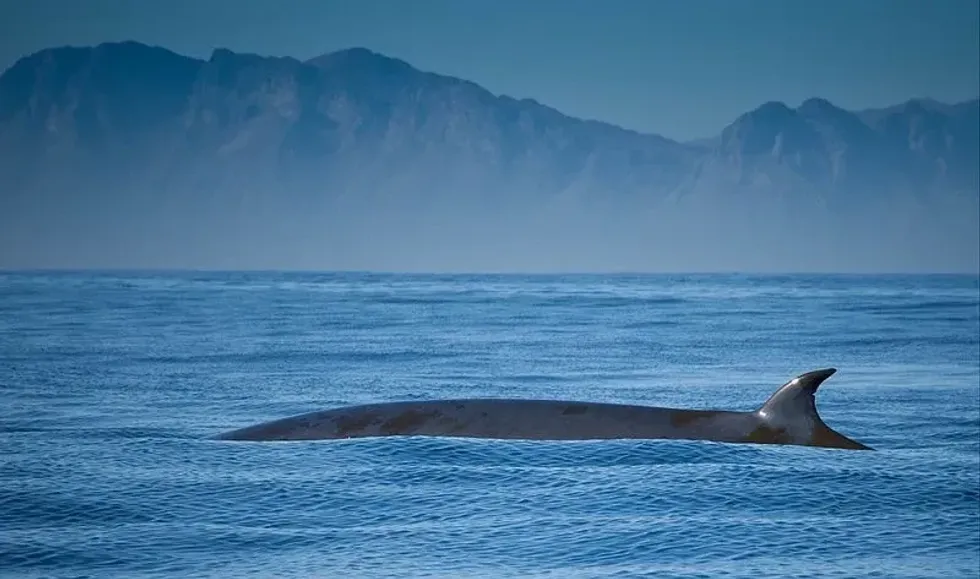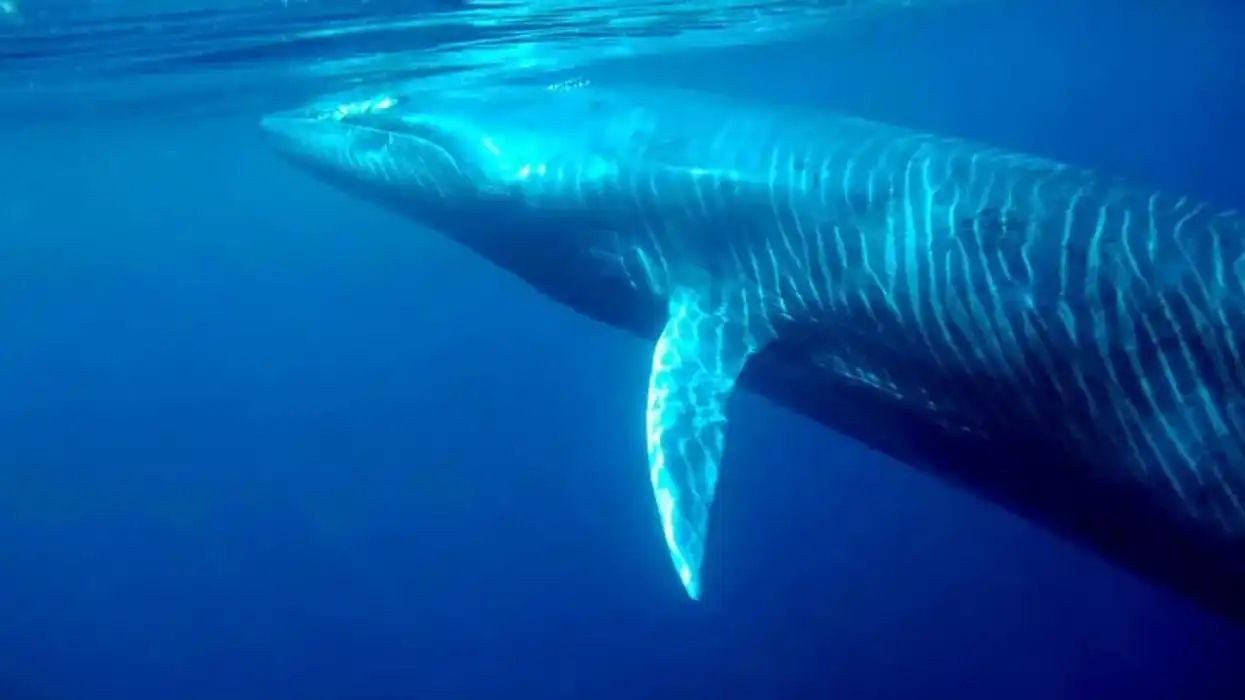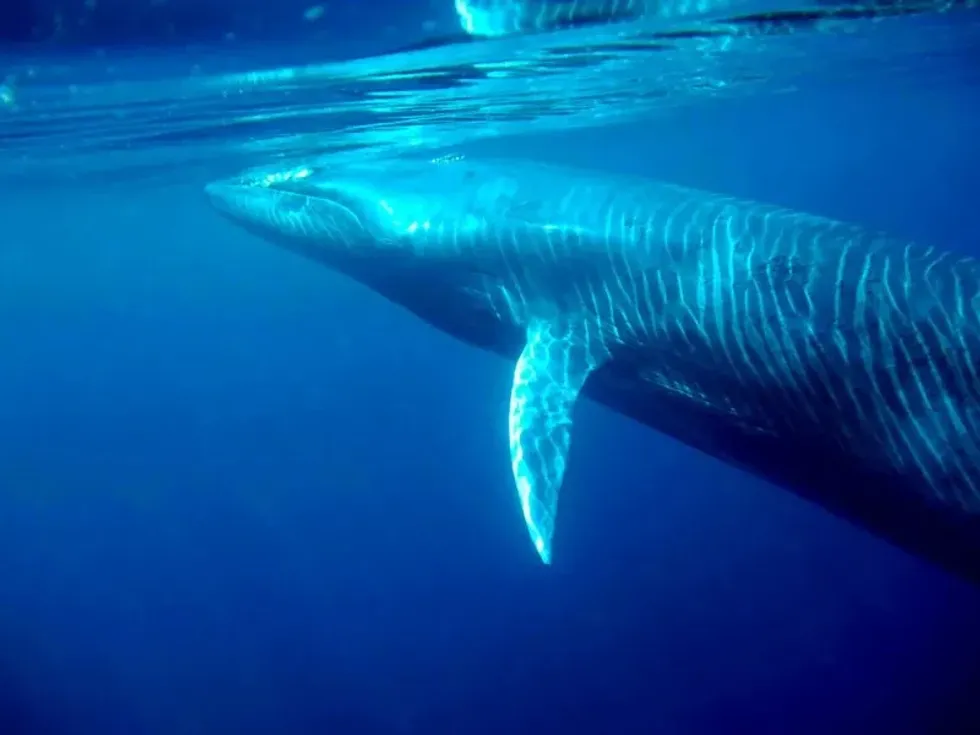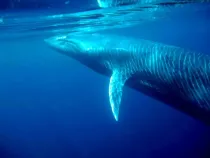Fun Bryde's Whale Facts For Kids

Bryde's whales are members of the baleen whale family and are more popularly referred to as the Bryde's whale complex with two currently recognized subspecies; the larger common Bryde's whale (Balaenoptera edeni brydei) and the relatively smaller Eden's whale (Balaenoptera edeni edeni).
Often confused with other whale species such as the sei whales, Bryde's whales are considered to be among the group of rorquals or great whales that also includes the humpback whales and the blue whales.
The Bryde's whale species are mainly concentrated between 40 degrees south and 40 degrees north latitudes. Preferring coastal tropical, sub-tropical, and warm temperate waters around the world, members of this marine mammal species are also known as tropical whales.
To be more specific, these whales are found in the Pacific, Atlantic, and Indian Oceans, both offshore and inshore.
These baleen whales are dark smoky-gray in color with a sleek and slender body and three prominent ridges on their rostrum.
With a head that makes up almost a quarter of its body length, the Bryde's whale looks quite similar to the sei whales but is much smaller. They primarily feed on small schooling fish and various crustaceans and, when at the water's surface, can blow water 10-13 ft (3-4 m) into the air!
Do you find the Bryde's whales interesting? Then read on to know more about these unique marine mammals!
If you like what you read, do check out fascinating facts about the sei whale and killer whale.
Bryde's Whale Interesting Facts
What type of animal is a Bryde's whale?
Bryde's whales are great whales or rorquals belonging to the baleen whale family. The Bryde's whale complex has two recognized subspecies - the common Bryde's whale (Balaenoptera edeni brydei) and Eden's whale (Balaenoptera edeni edeni).
What class of animal does a Bryde's whale belong to?
Bryde's whales belong to the class of mammals.
How many Bryde's whale are there in the world?
According to the latest stock assessment reports of NOAA fisheries, the population size of the eastern tropical pacific stock of Bryde's whale is about 13,000 animals, the Hawaiian stock has around 1,751 individuals, and the stock from the northern Gulf of Mexico has an alarmingly small population of these marine mammals, about 33, taking the Gulf of Mexico stock closer to the list of endangered species.
No information is available regarding the overall population size of the Bryde's whales around the world.
Where does a Bryde's whale live?
Bryde's whales live in warm marine waters. They are particularly concentrated in warm temperate, tropical, and subtropical ocean waters from 40 degrees south to 40 degrees north latitudes.
What is a Bryde's whale's habitat?
Bryde's whales inhabit the subtropical, tropical, and warm temperate waters of the Atlantic, Indian, and Pacific Oceans.
They are predominantly concentrated in waters with temperatures ranging between 60.8-68 F (16-20 C). The Bryde's whales spend most of their day within 50 ft (15.2 m) of the water's surface.
Even though researchers believe that the Bryde's whales are one of the few species of whales that do not undertake long-distance migration, some populations of these marine mammals are known to migrate with the seasons, moving towards the equator during the winter and moving away from the equator during the warmer months.
Who do Bryde's whale live with?
Bryde's whales may be either seen alone or in pairs. Members of this marine mammal species have been known to form loose groups of up to 20 individuals in feeding areas.
How long does a Bryde's whale live?
In the wild, the lifespan of the Bryde's whales can range between 50-70 years.
How do they reproduce?
Even though the reproductive behavior of the Bryde's whales is poorly understood, it is assumed that their mating system is similar to that of related cetaceans comprising other whales, dolphins, and porpoises. While members of this baleen whale species can mate all year round, what's unique about this marine mammal is that they breed in alternate years.
The gestation period lasts for around 11-12 months, and calves are nursed by their mothers for 6-12 months after birth. Usually, one calf is produced every breeding season.
The reason behind these baleen whales breeding every alternate year is that once the calves reach maturity at six months of age, the female Bryde's whales go through a recovery period of six months. The newborn calves measure about 11 ft (3.3 m) and weigh approximately 2,000 lb (907.1 kg).
The male Bryde's whales do not contribute to caring for the young, and once the young ones are weaned, they are left to fend for themselves.
The female Bryde's whales reach reproductive maturity when they are about 10 years old, and the males do so between the ages of 9-13 years. At the time of reaching sexual maturity, Bryde's whales measure about 39 ft (11.8 m).
What is their conservation status?
As per a 2017 assessment by the International Union for Conservation of Nature (IUCN) Red List of Threatened Species, the Bryde's whale (Balaenoptera edeni) is a species of Least Concern.
Bryde's Whale Fun Facts
What do Bryde's whale look like?
The dorsal (back) surface of Bryde's whales is predominantly dark smoky gray or blue-black in color, and the ventral (lower) surface is light cream to white with shades of grayish purple.
Unlike other baleen whales, Bryde's whales have three prominent longitudinal ridges on the V-shaped rostrum running from the tip of their snout to the front of the blowhole. While the dorsal fin of this marine mammal is hooked like a sickle, the other fins are pointed, narrow, and short.
The flippers are small, slender, and pointed, and the notched tail flukes are broad, occupying almost 24% of the length of the body.
Since this marine mammal is a filter feeder, they have about 40-70 throat grooves or pleats on their underside that allow their mouths to expand while feeding. In addition, the Bryde's whales have 250-410 gray-colored coarse baleen plates on either side of their mouth for straining their food while they feed in the seawater.
Members of most populations of Bryde's whales have a short but very broad head with large eyes. Individuals that migrate often have their bodies scarred by cookie-cutter sharks and lampreys.

How cute are they?
Marine Bryde's whales do not quite fit the definition of cute. However, their sleek body and protruding rostrum do make the Bryde's whales look graceful as they swim through the water or break the surface.
How do they communicate?
The Bryde's whales emit loud and short low-frequency calls that sound like moans. These calls are mainly produced when these whales are in motion and are repeated every one to three minutes.
These marine animals usually call back and forth, and the type of sound emitted usually varies with the size of the group.
Even though the Bryde's whales have ear structures that are adapted for echolocation (the ability to locate distant objects through the reflection of sound waves to the emitter), they are not known to exhibit the phenomenon (unlike species of toothed whales). It is likely that the Bryde's whales do not have any sense of smell.
How big is a Bryde's whale?
Bryde's whales range in length between 45-55 ft (13.7-16.7 m). Females are slightly larger than the males. Bryde's whales are almost half the size of the species of blue whales.
How fast can a Bryde's whale swim?
A Bryde's whale can normally swim at 1-4 mph (1.6-6.4 kph), but swimming speeds can reach up to 12-15 mph (19.3-24.1 kph).
How much does a Bryde's whale weigh?
The average Bryde's whale weighs about 90,000 lb (40,823.3 kg).
What are the male and female names of the species?
In general, a male whale is called a bull, and a female whale is called a cow.
What would you call a baby Bryde's whale?
Like all other species of whales, a baby Bryde's whale would be called a calf.
What do they eat?
The diet of Bryde's whales predominantly includes shrimps, red crabs, copepods, krill, and a variety of schooling fish such as sardines, pilchards, mackerel, and herrings. Their year-round habitation in warm waters ensures an abundant and continuous supply of food.
Being filter feeders, this species of baleen whales use multiple techniques for feeding, such as creating bubble nets, lunging, and skimming the water surface.
Are they dangerous?
Baleen whales are not known to be dangerous to humans. Further, since species of baleen whales do not have teeth, they are not capable of tearing apart and eating a human, and their narrow throat makes it impossible to swallow a whole animal.
Would they make a good pet?
Due to their sheer size, Bryde's whales are not suitable for keeping as pets. Further, these whales are protected species, and it is downright illegal to own or pet them.
Did you know...
Johan Bryde was a Norwegian consul to South Africa, and it is after him that the Bryde's whale gets its common name.
John Anderson was a Scottish zoologist and the first curator of the Indian Museum (Calcutta, India). He described Balaenoptera edeni and named it after Sir Ashley Eden, former British High Commissioner in Burma. Sir Eden had helped Anderson to obtain the type specimen of the whale.
Bryde's whales can dive up to 1,000 ft (304.8 m) for about five to 15 minutes. The maximum dive duration can go up to 20 minutes.
Omura's whale (Balaenoptera omurai) was initially considered to be a pygmy form of the Bryde's whales.
The Rice's whale (Balaenoptera ricei) endemic to the Gulf of Mexico was initially considered to be a subpopulation of the Bryde's whales but was elucidated as a separate species in 2021.
Bryde's whales are protected by the U.S. Marine Mammal Protection Act, 1972, and are also listed in Appendix II of CITES.
Even though the International Whaling Commission was set up in 1986 to check the hunting and killing of whales for their oil, meat, and bones, the poor animals continue to be prey to human greed and negligence.
Primary threats to populations of Bryde's whales include commercial whaling, oil spills, vessel strikes, entanglement in fishing gear, and ocean noise.
Commercial whaling is most common off the coasts of the Phillippines and Indonesia and in Japan, where this species is part of scientific research whaling programs. Bryde's whales are the third most common species to be injured or killed by vessel strikes, particularly in coastal areas where vessel traffic is very high.
In addition, underwater noise pollution interrupts the whales' normal life by interfering with their ability to use sound as a means of communication, navigation, finding food, choosing mates, and escaping predators.
How deep can a Cuvier's beaked whale dive?
Cuvier's beaked whales have been observed to reach diving depths of nearly 10,000 ft (about 3,048 m).
Do beaked whales have teeth?
Most species of beaked whales have only one pair of teeth, a unique feature among the toothed whales. The teeth resemble tusks and are only visible in male whales. In females, the teeth remain undeveloped and hidden in the gum tissues.
Here at Kidadl, we have carefully created lots of interesting family-friendly animal facts for everyone to discover! For more relatable content, check out these whalefish facts and fin whale facts for kids.
You can even occupy yourself at home by coloring in one of our free printable fin whale coloring pages.
We Want Your Photos!
More for You
See All
Bachelor of Arts specializing in Journalism and Mass Communication, Postgraduate Diploma in Sports Management

Moumita DuttaBachelor of Arts specializing in Journalism and Mass Communication, Postgraduate Diploma in Sports Management
A content writer and editor with a passion for sports, Moumita has honed her skills in producing compelling match reports and stories about sporting heroes. She holds a degree in Journalism and Mass Communication from the Indian Institute of Social Welfare and Business Management, Calcutta University, alongside a postgraduate diploma in Sports Management.
Postgraduate Diploma in Management

Sakshi RaturiPostgraduate Diploma in Management
Sakshi has experience in marketing strategy, social media planning, and recruiting industry experts for capstone projects, she has displayed a commitment to enhancing their skills and knowledge. She has won multiple awards, including a Certificate of Appreciation for Creative Writing and a Certificate of Merit for Immaculate Turut, and is always seeking new opportunities to grow and develop.
Disclaimer
1) Kidadl is independent and to make our service free to you the reader we are supported by advertising. We hope you love our recommendations for products and services! What we suggest is selected independently by the Kidadl team. If you purchase using the Buy Now button we may earn a small commission. This does not influence our choices. Prices are correct and items are available at the time the article was published but we cannot guarantee that on the time of reading. Please note that Kidadl is a participant in the Amazon Services LLC Associates Program, an affiliate advertising program designed to provide a means for sites to earn advertising fees by advertising and linking to Amazon. We also link to other websites, but are not responsible for their content.
2) At Kidadl, we strive to recommend the very best activities and events. We will always aim to give you accurate information at the date of publication - however, information does change, so it’s important you do your own research, double-check and make the decision that is right for your family. We recognise that not all activities and ideas are appropriate for all children and families or in all circumstances. Our recommended activities are based on age but these are a guide. We recommend that these ideas are used as inspiration, that ideas are undertaken with appropriate adult supervision, and that each adult uses their own discretion and knowledge of their children to consider the safety and suitability. Kidadl cannot accept liability for the execution of these ideas, and parental supervision is advised at all times, as safety is paramount. Anyone using the information provided by Kidadl does so at their own risk and we can not accept liability if things go wrong.
3) Because we are an educational resource, we have quotes and facts about a range of historical and modern figures. We do not endorse the actions of or rhetoric of all the people included in these collections, but we think they are important for growing minds to learn about under the guidance of parents or guardians.







